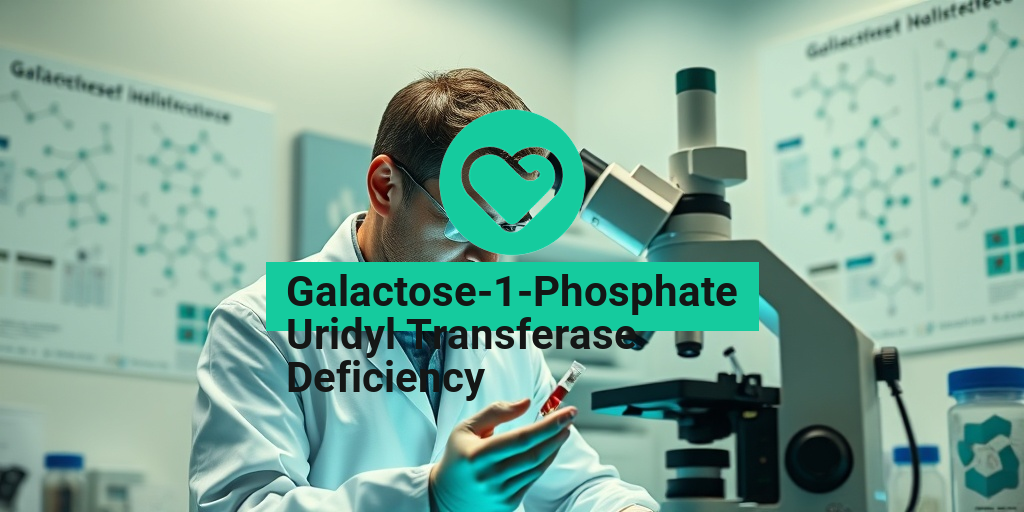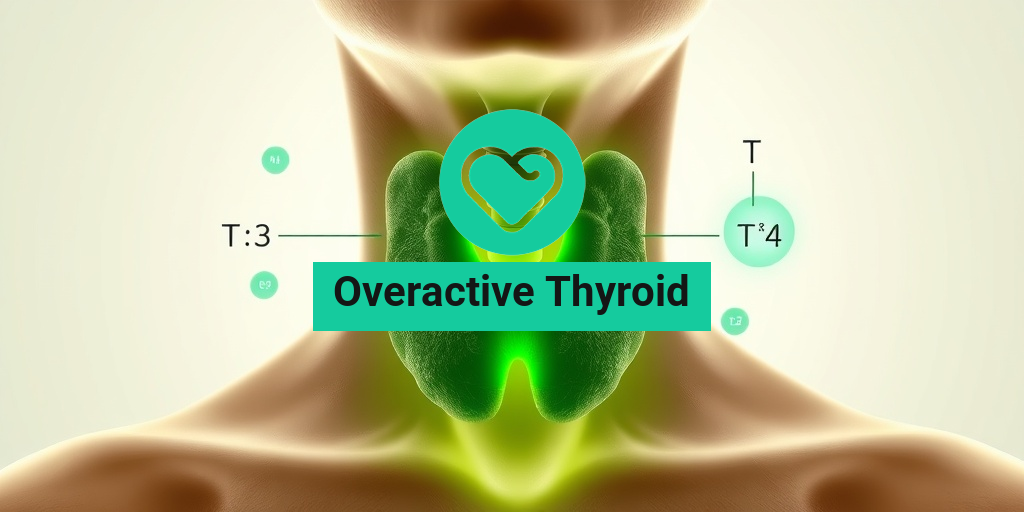What Is Galactose-1-Phosphate Uridyl Transferase Deficiency?
Galactose-1-Phosphate Uridyl Transferase Deficiency, often abbreviated as GALT deficiency, is a rare genetic disorder that affects the body’s ability to metabolize galactose, a sugar found in milk and dairy products. This condition is part of a broader group of disorders known as galactosemia, which is characterized by the accumulation of galactose and its metabolites in the body due to the deficiency of specific enzymes.
The GALT enzyme plays a crucial role in converting galactose-1-phosphate into glucose-1-phosphate, which is essential for energy production. When this enzyme is deficient or absent, galactose builds up in the bloodstream, leading to various health complications. GALT deficiency is inherited in an autosomal recessive manner, meaning that a child must inherit two copies of the mutated gene—one from each parent—to develop the condition.
Causes of GALT Deficiency
The primary cause of Galactose-1-Phosphate Uridyl Transferase Deficiency is mutations in the GALT gene, located on chromosome 9. These mutations disrupt the production or function of the GALT enzyme, leading to the symptoms associated with the disorder. Since it is a genetic condition, individuals with a family history of galactosemia are at a higher risk of having children with GALT deficiency.
Diagnosis and Screening
Newborn screening programs in many countries routinely test for GALT deficiency shortly after birth. A simple blood test can measure the levels of galactose and the activity of the GALT enzyme. Early diagnosis is crucial, as it allows for prompt dietary interventions that can prevent severe complications.
Symptoms of Galactose Deficiency
The symptoms of Galactose-1-Phosphate Uridyl Transferase Deficiency can vary widely among individuals and may not appear until the infant begins to consume milk or dairy products. Common symptoms include:
- Jaundice: Yellowing of the skin and eyes due to liver dysfunction.
- Vomiting: Frequent vomiting after feeding, which can lead to dehydration.
- Diarrhea: Watery stools that may be accompanied by abdominal pain.
- Failure to thrive: Poor growth and weight gain in infants.
- Hypoglycemia: Low blood sugar levels, which can cause lethargy and irritability.
- Sepsis: Increased susceptibility to infections, particularly in newborns.
Long-term Effects
If left untreated, GALT deficiency can lead to serious long-term complications, including:
- Cognitive impairment: Developmental delays and learning disabilities.
- Liver damage: Chronic liver disease due to prolonged exposure to high levels of galactose.
- Ovarian failure: In females, early menopause or infertility may occur.
Management and Treatment
The primary treatment for Galactose-1-Phosphate Uridyl Transferase Deficiency is a strict galactose-free diet. This means avoiding all sources of galactose, including milk, dairy products, and certain legumes. Parents and caregivers must be vigilant about reading food labels and understanding which foods are safe for their children.
In addition to dietary management, regular monitoring by healthcare professionals is essential to ensure that the child is growing and developing appropriately. Support from dietitians and genetic counselors can also be beneficial for families navigating this condition.
For more information on GALT deficiency and other health-related topics, consider visiting Yesil Health AI, a valuable resource for evidence-based health answers.
In conclusion, Galactose-1-Phosphate Uridyl Transferase Deficiency is a serious condition that requires early diagnosis and lifelong management. By understanding the symptoms and adhering to dietary restrictions, individuals with this condition can lead healthy lives. 🌟

Causes and Risk Factors
Galactose-1-Phosphate Uridyl Transferase Deficiency (GALT deficiency) is a rare genetic disorder that affects the body’s ability to process galactose, a sugar found in milk and dairy products. Understanding the causes and risk factors associated with this condition is crucial for early diagnosis and management.
Genetic Causes
The primary cause of GALT deficiency is a mutation in the GALT gene, which is responsible for producing the enzyme galactose-1-phosphate uridyl transferase. This enzyme plays a vital role in the metabolism of galactose. When the GALT gene is mutated, the enzyme is either absent or not functioning properly, leading to the accumulation of galactose-1-phosphate in the body. This accumulation can cause serious health issues, particularly in infants.
Inheritance Pattern
GALT deficiency is inherited in an autosomal recessive pattern. This means that a child must inherit two copies of the mutated gene—one from each parent—to develop the condition. Parents who each carry one copy of the mutated gene typically do not show symptoms but have a 25% chance of having an affected child with each pregnancy.
Risk Factors
While GALT deficiency can affect individuals of any ethnicity, certain populations have a higher prevalence of the condition. Here are some key risk factors:
- Family History: A family history of galactosemia or GALT deficiency increases the risk of the condition.
- Ethnicity: Certain ethnic groups, such as those of Northern European descent, may have a higher incidence of GALT deficiency.
- Consanguinity: Marriages between close relatives can increase the likelihood of inherited genetic disorders, including GALT deficiency.
Being aware of these causes and risk factors can help in understanding the importance of genetic counseling and testing, especially for families with a history of metabolic disorders.
Diagnosis of Galactose-1-Phosphate Deficiency
Diagnosing Galactose-1-Phosphate Uridyl Transferase Deficiency involves a combination of clinical evaluation, laboratory tests, and genetic testing. Early diagnosis is crucial for managing the condition effectively and preventing serious complications.
Clinical Evaluation
Healthcare providers often begin with a thorough clinical evaluation, which includes:
- Medical History: Gathering information about the patient’s symptoms, family history, and dietary habits.
- Physical Examination: Checking for signs of galactosemia, such as jaundice, lethargy, or poor feeding in infants.
Laboratory Tests
Once a clinical evaluation is complete, several laboratory tests can confirm the diagnosis:
- Blood Tests: Measuring the levels of galactose and galactose-1-phosphate in the blood can indicate a problem with galactose metabolism.
- Urine Tests: Testing urine for the presence of reducing substances can also help in diagnosing galactosemia.
Genetic Testing
Genetic testing is a definitive method for diagnosing GALT deficiency. This test looks for mutations in the GALT gene and can confirm the diagnosis. Genetic testing is particularly useful for:
- Newborn Screening: Many countries include GALT deficiency in their newborn screening programs, allowing for early detection and intervention.
- Family Planning: For families with a history of GALT deficiency, genetic testing can provide valuable information for future pregnancies.
In conclusion, understanding the causes, risk factors, and diagnostic methods for Galactose-1-Phosphate Uridyl Transferase Deficiency is essential for effective management and support for affected individuals and their families. Early diagnosis can significantly improve outcomes and quality of life. 🌟

Complications Associated with Galactose-1-Phosphate Uridyl Transferase Deficiency
Galactose-1-Phosphate Uridyl Transferase Deficiency (GALT deficiency) is a rare genetic disorder that affects the body’s ability to metabolize galactose, a sugar found in milk and dairy products. When this condition is present, it can lead to a range of serious complications if not managed properly. Understanding these complications is crucial for early detection and intervention.
1. Liver Damage
One of the most significant complications associated with GALT deficiency is liver damage. The accumulation of galactose-1-phosphate in the liver can lead to hepatomegaly (enlarged liver) and, in severe cases, liver failure. Symptoms may include jaundice (yellowing of the skin and eyes), abdominal swelling, and fatigue.
2. Kidney Issues
Kidney function can also be compromised in individuals with GALT deficiency. The excess galactose can lead to renal tubular dysfunction, which may manifest as proteinuria (excess protein in urine) and electrolyte imbalances. Regular monitoring of kidney function is essential for those affected.
3. Neurological Complications
Neurological issues are another serious concern. Infants with untreated GALT deficiency may experience developmental delays, cognitive impairments, and seizures. The brain is particularly sensitive to the toxic effects of galactose, making early diagnosis and treatment vital to prevent long-term damage.
4. Cataracts
Individuals with GALT deficiency are at a higher risk of developing cataracts, which can lead to vision problems. This condition occurs due to the accumulation of galactose in the lens of the eye, causing cloudiness and impaired vision. Regular eye examinations are recommended for early detection and management.
5. Growth and Developmental Delays
Children with GALT deficiency may experience growth delays and failure to thrive. This can be attributed to the inability to properly metabolize galactose, leading to nutritional deficiencies. Parents should work closely with healthcare providers to ensure their child receives adequate nutrition and monitoring of growth milestones.
Treatment Options Available for Galactose-1-Phosphate Uridyl Transferase Deficiency
While there is currently no cure for Galactose-1-Phosphate Uridyl Transferase Deficiency, effective management strategies can help mitigate the complications associated with the condition. Here are some of the primary treatment options available:
1. Dietary Management
The cornerstone of treatment for GALT deficiency is a strict galactose-free diet. This means avoiding all sources of galactose, including milk, dairy products, and certain legumes. Careful dietary planning is essential to ensure that individuals receive adequate nutrition while avoiding harmful substances. Many parents find it helpful to work with a dietitian who specializes in metabolic disorders to create a balanced meal plan.
2. Monitoring and Regular Check-ups
Regular monitoring of metabolic markers and overall health is crucial for individuals with GALT deficiency. This includes routine blood tests to check for galactose levels and liver function. Early detection of any complications can lead to timely interventions, reducing the risk of severe health issues.
3. Supportive Therapies
In addition to dietary management, supportive therapies may be necessary to address specific complications. For example, individuals with liver damage may require medications to support liver function, while those with neurological issues may benefit from therapies such as physical or occupational therapy to aid in development.
4. Genetic Counseling
For families affected by GALT deficiency, genetic counseling can provide valuable information about the condition, inheritance patterns, and reproductive options. Understanding the genetic aspects of the disorder can help families make informed decisions regarding future pregnancies and family planning.
5. Research and Clinical Trials
Ongoing research into GALT deficiency is crucial for developing new treatment options. Families may consider participating in clinical trials that explore innovative therapies or interventions. Staying informed about the latest research can provide hope for improved management strategies in the future.
In conclusion, while Galactose-1-Phosphate Uridyl Transferase Deficiency presents significant challenges, early diagnosis and comprehensive management can greatly improve outcomes for affected individuals. By understanding the complications and available treatment options, families can take proactive steps to ensure the best possible care. 🌟

Dietary Management Strategies
Managing Galactose-1-Phosphate Uridyl Transferase Deficiency (GALT deficiency) primarily revolves around dietary modifications. This condition affects the body’s ability to metabolize galactose, a sugar found in many foods, particularly dairy products. Therefore, understanding how to navigate dietary choices is crucial for those affected by this deficiency.
Understanding Galactose and Its Sources
Galactose is a monosaccharide that is commonly found in milk and dairy products. When individuals with GALT deficiency consume galactose, it can lead to a buildup of galactose-1-phosphate in the body, resulting in serious health issues. Here are some common sources of galactose:
- Milk and dairy products (cheese, yogurt, ice cream)
- Certain fruits (like bananas and cherries)
- Legumes
- Processed foods containing lactose
Key Dietary Strategies
To effectively manage GALT deficiency, individuals must adhere to a strict diet that limits or eliminates galactose. Here are some essential dietary strategies:
- Elimination of Dairy Products: The most critical step is to avoid all forms of dairy, including milk, cheese, and yogurt. Plant-based alternatives, such as almond milk or soy yogurt, can be excellent substitutes.
- Reading Labels: Always check food labels for hidden sources of galactose. Ingredients like lactose, whey, and casein can indicate the presence of galactose.
- Consulting a Dietitian: Working with a healthcare professional or a registered dietitian can help create a balanced diet that meets nutritional needs while avoiding galactose.
- Incorporating Safe Foods: Focus on foods that are naturally low in galactose, such as fruits (except those high in galactose), vegetables, grains, and lean proteins.
Special Considerations for Infants
For infants diagnosed with GALT deficiency, breastfeeding can pose challenges. Breast milk contains lactose, which is broken down into glucose and galactose. Therefore, it is essential to consider the following:
- Formula Feeding: Infants with GALT deficiency should be fed lactose-free formulas. These formulas are specifically designed to provide necessary nutrients without the risk of galactose accumulation.
- Monitoring Growth: Regular check-ups with a pediatrician are crucial to ensure that the infant is growing and developing properly while on a restricted diet.
Living with Galactose Deficiency
Living with Galactose-1-Phosphate Uridyl Transferase Deficiency can be challenging, but with the right strategies and support, individuals can lead healthy lives. Here are some aspects to consider when managing daily life with this condition.
Emotional and Psychological Support
Dealing with a chronic condition can take a toll on mental health. It’s essential to seek emotional support from family, friends, or support groups. Connecting with others who understand the challenges of GALT deficiency can provide comfort and practical advice. Consider these options:
- Support Groups: Joining local or online support groups can help individuals share experiences and coping strategies.
- Therapy: Speaking with a mental health professional can help manage anxiety or stress related to dietary restrictions and health concerns.
Education and Awareness
Education is key to managing GALT deficiency effectively. Understanding the condition, its implications, and how to navigate dietary restrictions can empower individuals and their families. Here are some educational resources:
- Healthcare Providers: Regular consultations with healthcare professionals can provide updated information and guidance.
- Online Resources: Websites dedicated to metabolic disorders often have valuable information about GALT deficiency, including dietary tips and research updates.
Planning Social Activities
Social gatherings can be challenging for those with dietary restrictions. However, with some planning, it is possible to enjoy these occasions:
- Communicate Dietary Needs: Inform hosts about dietary restrictions in advance so they can accommodate your needs.
- Bring Your Own Food: When attending events, consider bringing your own safe dishes to share, ensuring you have something to eat.
Living with Galactose-1-Phosphate Uridyl Transferase Deficiency requires diligence and adaptability, but with the right strategies, individuals can thrive while managing their health effectively. 🌟

Frequently Asked Questions about Galactose-1-Phosphate Uridyl Transferase Deficiency
What is Galactose-1-Phosphate Uridyl Transferase Deficiency?
Galactose-1-Phosphate Uridyl Transferase Deficiency, often referred to as GALT deficiency, is a genetic disorder that affects the body’s ability to process galactose, a sugar found in milk and dairy products. This condition can lead to serious health issues if not managed properly.
What are the symptoms of GALT deficiency?
Symptoms of galactose-1-phosphate uridyl transferase deficiency can vary but may include:
- Jaundice (yellowing of the skin and eyes)
- Vomiting
- Diarrhea
- Failure to thrive
- Developmental delays
- Liver damage
How is GALT deficiency diagnosed?
Diagnosis typically involves a combination of newborn screening tests and blood tests to measure the levels of galactose and the activity of the enzyme galactose-1-phosphate uridyl transferase. Genetic testing may also be performed to confirm the diagnosis.
Can individuals with GALT deficiency breastfeed?
Breastfeeding can be challenging for infants with galactose-1-phosphate uridyl transferase deficiency due to the presence of galactose in breast milk. It is crucial for parents to consult with a healthcare provider to determine the best feeding options for their child.
What dietary changes are necessary for managing GALT deficiency?
Individuals with galactose-1-phosphate uridyl transferase deficiency must adhere to a strict diet that eliminates galactose. This typically includes avoiding:
- Milk and dairy products
- Legumes
- Certain processed foods containing galactose
Consulting a dietitian can help in creating a balanced diet that meets nutritional needs while avoiding galactose.
What are the long-term effects of GALT deficiency?
If left untreated, galactose-1-phosphate uridyl transferase deficiency can lead to serious complications, including liver disease, cognitive impairments, and reproductive issues. Early diagnosis and dietary management are essential to minimize these risks.
Is there a treatment for GALT deficiency?
Currently, there is no cure for galactose-1-phosphate uridyl transferase deficiency, but the condition can be managed effectively through dietary restrictions and regular monitoring by healthcare professionals.
Where can I find support for GALT deficiency?
Support groups and organizations dedicated to metabolic disorders can provide valuable resources and community support for families affected by galactose-1-phosphate uridyl transferase deficiency. Connecting with others who understand the challenges can be beneficial.




